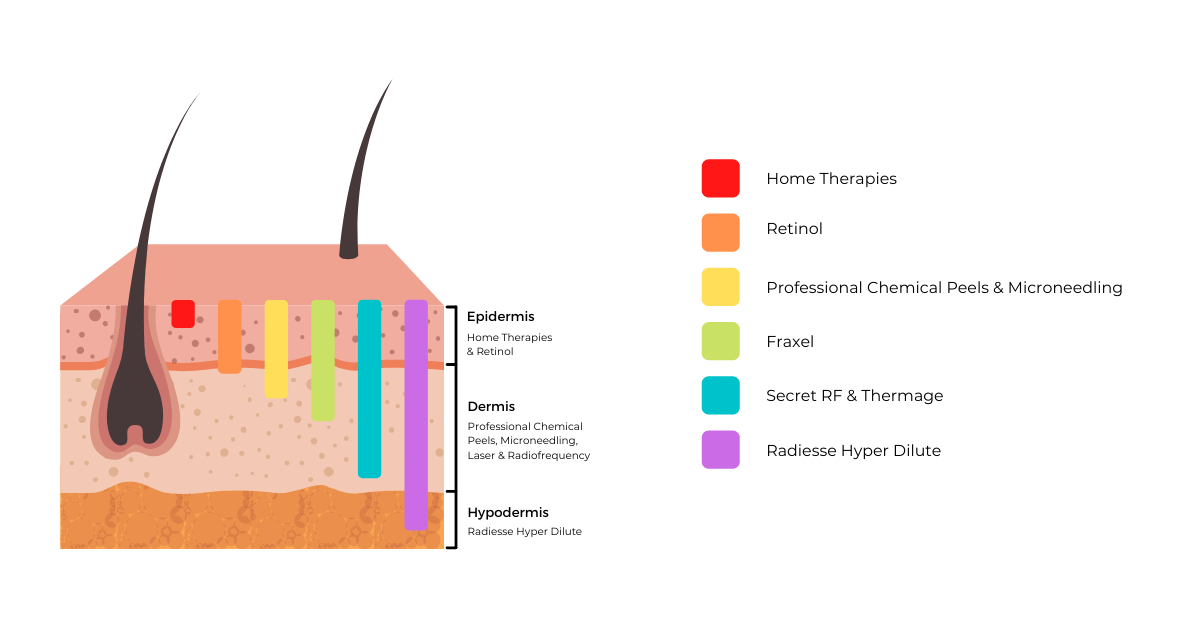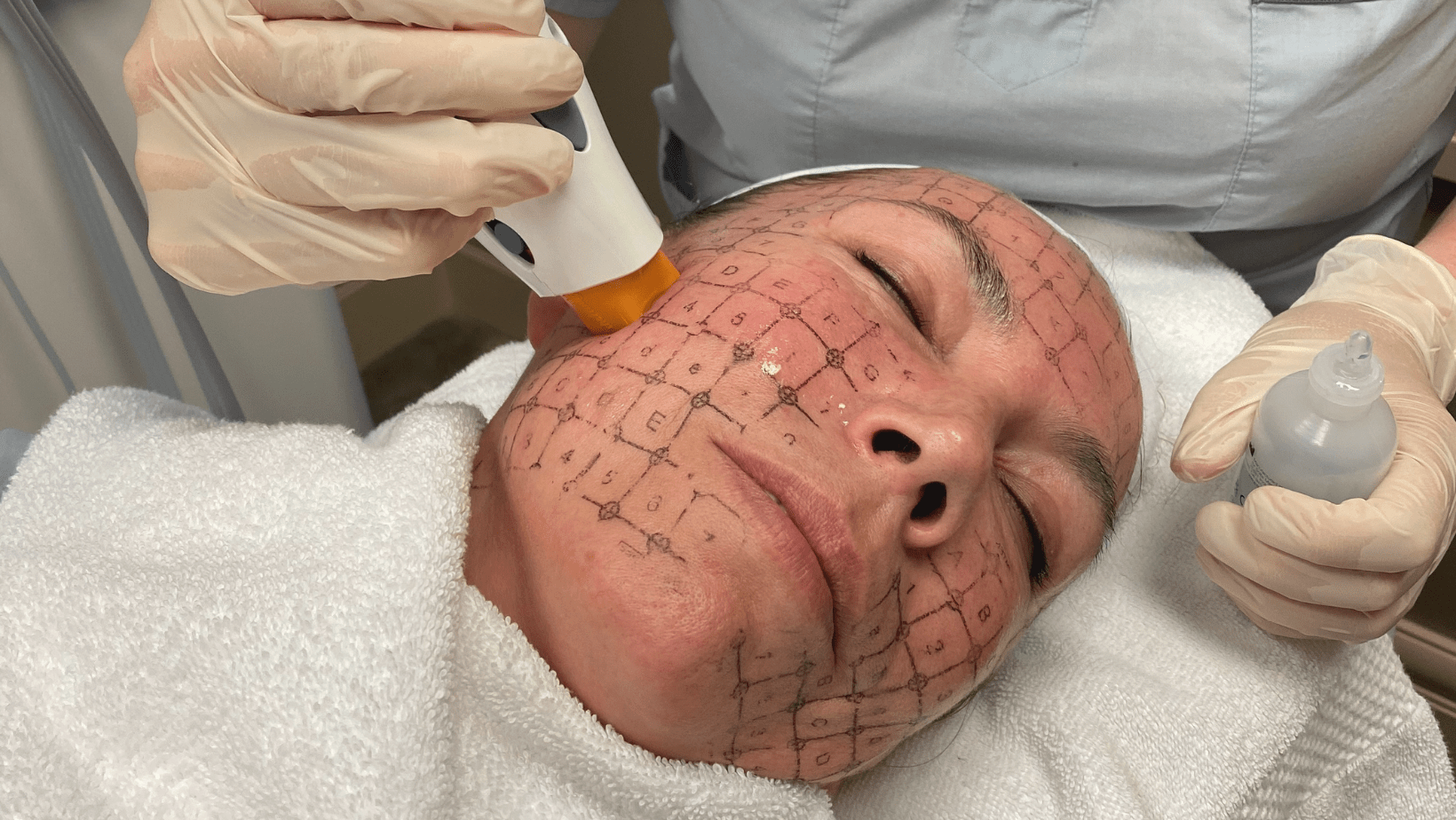The Best Ways to Treat Fine Lines and Wrinkles
Since the beginning of time, people have been selling ‘beauty’ in a bottle. From skincare products to various treatment technologies, there are now so many options promising guaranteed results that it is difficult to sort out which options are best for you.
Think about what you are trying to achieve. Are you looking for a nice moisturizer or are you wanting some skin tightening and correction of fine lines and wrinkles?
Before going any further, it is important to understand the layers of your skin.
Layers of Skin Demonstrating Depth of Specific Treatments

The top layer of skin that you see is called the Epidermis. It is made up of multiple layers of flattened cells and provides your body with a protective barrier. The outermost layer of the epidermis continually sheds or is exfoliated. It is this layer that skin products, facials, and home therapies target. At the base of the epidermis are cells called melanocytes that make melanin or pigment, and give skin its colour.
The Dermis is the middle layer of skin and it has two parts, the Superficial or Papillary Layer and the Reticular Layer. The papillary layer is just under the epidermis. It supplies nutrients to the epidermal layer and regulates body temperature. The deeper, reticular layer, is tougher. It strengthens the skin and provides it with elasticity. The reticular layer contains hair follicles, sweat glands, sebaceous glands, lymphatics, and nerve endings. It is the layer that has collagen bundles and elastin. This gives the skin strength and flexibility. The cells that make collagen and elastin are called fibroblasts.
Beneath the dermis is the Hypodermis or Subcutaneous Layer. It consists of a network of collagen and fat cells. It helps to conserve the body’s heat and acts as a “shock absorber” to protect the body from injury.
So, if you are just looking for a “freshen up” — targeting the epidermis with home therapies or spa facials can do that. However, if you want structural change, increased collagen, increased elastin, skin tightening, and the improvement of fine lines and wrinkles, you must target the dermis or hypodermis.
Now let us unpack your best treatment options based on how deep they go!
Home Therapies
There are many things that you can do from the comfort of your home to improve the look and quality of your sin. They will provide resurfacing of the superficial layer of the skin, the epidermis. Examples include dermarolling, facials, and over-the-counter chemical peels which can be done on a weekly basis.
One of the most effective home therapies is Retinol (Vitamin A). It is a well-researched healthy skin essential. Retinol upregulates the cell turnover cycle in the epidermis which then promotes the growth of collagen and elastin. It also regulates melanin production reducing pigmentation of the skin. If you experience hormonal acne, it reduces pore size and pore-clogging. Retinol penetrates the epidermis and slightly into the dermis. Over time, there will be an improvement of overall skin texture and tone, as well as minimizing fine lines and wrinkles. Consistent use is important. Real change is noticeable at 6 months.
Professional Therapies
To Significantly Improve the Structure of Skin, You Need to Go Deeper
There are a number of professional treatments using a variety of technologies that penetrate into the dermis. They essentially create a controlled wound in the skin which then triggers a wound healing response. This ultimately stimulates the fibroblasts to produce collagen and elastin.
Professional Chemical Peels: Professional chemical peels use concentrated acid solutions to resurface the skin. Depending on the strength and formulation of the peel, skin resurfacing will affect the epidermis or penetrate the dermis. They can target fine lines, discoloration, congested pores, uneven skin tone, and texture. They accelerate the natural cell turnover by breaking down the bonds that bind dead skin cells together, revealing the healthier skin cells underneath.
Microneedling: Microneedling is a treatment that creates millions of microscopic punctures at precise depths in the epidermal and dermal layers. Not only does the treatment trigger the wound healing response but it allows transdermal passage of molecules that would otherwise be too large to be absorbed. Topical serums such as Hyaluronic Acid, used during treatment, penetrate deeper into the skin through microchannels created by the needles. Skin may look a bit red for a day or two but is otherwise easy to tolerate and appropriate for any time of year.
Microneedling with Fractional Radiofrequency (RF) — i.e. Secret RF: This is a new, innovative technology combining microrneedling with fractional radiofrequency (RF). As the needles penetrate the skin, the radiofrequency current is released from the needle tips. This creates thermal (heat) zones in the dermis without damaging the epidermis or upper layer of skin. The treatment can be customized to penetrate various depths of the skin. By adding the radiofrequency, it amplifies collagen and elastin production, making it a great treatment option for fine lines, deeper wrinkles, scars, and stretch marks. There is minimal downtime, and it is a safe treatment for people of all skin types. It can also be done closer around the eyes. Sun protection is not necessary.
Laser Resurfacing — i.e. Fraxel Dual: This type of technology uses microscopic laser columns to penetrate the epidermis and dermis. lasers can be set to target pigment, scars, and vascular abnormalities, in addition to ramping up collagen production. It is the best treatment for pigmentation or significant acne scarring. With lasers, expect a few days of downtime with redness, swelling, bronzing, and/or peeling.
Radiofrequency — i.e. Thermage: This non-invasive technology uses monopolar radiofrequency energy to safely heat the deeper layers of the dermis and hypodermis, triggering a controlled wound healing response. There is progressive tightening over a six-month period with improvements lasting up to two years, depending on age and severity of skin laxity. The result is a deeper tightening, and contouring of the skin. It is a single treatment with no downtime.
Thermage Eyes: With all the benefits of Thermage, this is the best non-invasive treatment for hooding and tightening of the skin around the eye. Small shields are used to protect the eye which allows for treatment of the upper and lower eyelid.
Radiesse Hyper Dilute: Radiesse is a dermal filler that when diluted, acts as a biostimulator. When it is injected beneath the dermis, it creates a scaffold or framework, and then it stimulates collagen and elastin production. Following treatment, you can expect general skin tightening, natural dermal thickening, and the improvement of fine lines and crepiness over the next six months. There is no downtime and the effects are still noticeable at 18 months post-treatment.
In summary, it’s the collagen and elastin in the dermal layer that gives the skin structure, tone, and elasticity. AS we age, we lost 1% collagen per year starting at age 25. To correct that progressive breakdown, a treatment targeting that deeper layer must be performed. And like any self care, it should be maintained.

